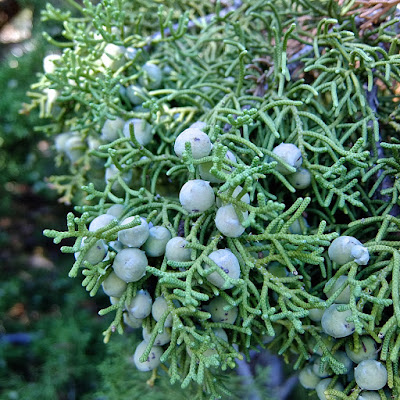Juniperus californica
 |
| California Juniper: photo by Cliff Hutson |
California Juniper is a shrub-like tree that is native to California and is found only slightly beyond California’s borders; a short distance into the Great Basin in southern Nevada, northwestern Arizona, and Baja California. Throughout our state it is found in the Peninsular Ranges, Transverse Ranges, California Coast Ranges, Sacramento Valley foothills, Sierra Nevada, and at higher elevation sky islands in the Mojave Desert ranges in Pinyon-Juniper Woodland, Joshua Tree Woodland, and Foothill Woodland communities. It is a member of the Cupressaceae or cypress family
The plant can grow to forty feet in height, but is usually much shorter (10-15 ft.). The leaves are scalelike, and yellow-green in color. The bark is ashy gray to brown, and furrowed or shredded in appearance. The “berries” are actually cones (7–12 mm) which are described as bluish (although they look greenish to me), with a bloom, and contain one or two seeds. The cones are red-brown when dry. California juniper is said to be dioecious, producing cones of only one sex on an individual plant. But a small percentage of plants are monoecious, i.e., both sexes on the same plant.
Juniperus californica provides food and shelter for a variety of mammals and birds. Notably, it is a larval host for the native moth Sequoia sphinx (Sphinx sequoiae). It is popular species for bonsai; and also has value as an ornamental being drought-tolerant and requiring no water after it is established.
Indigenous people used the wood for sinew-backed bows. South Coast Province people also ground up the cones and molded them into cakes, which were said to taste sweet. It is reported that other groups ate the berries fresh or prepared them as a mush. A medical decoction was also used to treat rheumatism and urinary problems.



